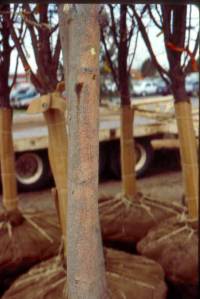In the summer, trees provide shade from blazing sunlight and help lower our air conditioner bills. On top of that, these impressive plants absorb pollutants, such as carbon dioxide, from the air and emit oxygen so we can breathe more easily.
So in the winter, it’s payback time for trees. We need to look out for them the way they look out for us.
How? There are several ways:
Wrap trees to prevent sunscald and discourage frost cracking. Protect your young, thin-barked trees by wrapping them in the fall, preferably around Halloween. If you’re like me, you may not get around to it till November. It’s still not too late to do it now before snow starts, causing reflection of sunlight off of snow and onto trees. But get it done. Then be sure to take the tree wrap off around Easter so insects don’t burrow under it and start munching or building nests. CSU offers tree-wrapping tips.

Water trees once a month. Do this only when temperatures are above 40 degrees, and do it during mid-day so water has time to soak into the ground before freezing at night. But don’t water where there’s snow on the ground.
Place a hose at the drip line (under the widest part of the tree canopy, where rain would drip from the branches to the ground) and let water trickle into the ground. Move the hose periodically until you’ve gone all the way around the tree. Evergreens, in particular, need winter watering because they lose water through their needles in dry air.

Prune trees when necessary, usually during dormant season. Have you ever noticed all the broken branches after a major snowstorm? Breakage usually results from poor tree maintenance. That’s one reason it’s important to keep your trees pruned.
Winter is the best time to prune most trees, especially species that are susceptible to fire blight. I’m talking about apples, crabapples, pears, serviceberries and hawthorns, among others.
Also, after the leaves fall, you can assess a tree’s structure and problem areas more accurately before pruning.
Take good care of your trees in winter, and they’ll stick around to take care of you the rest of the year.


